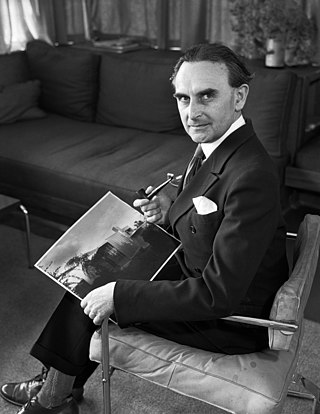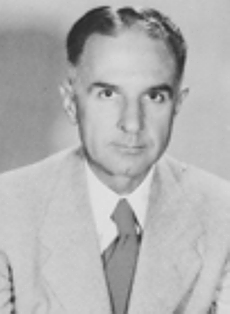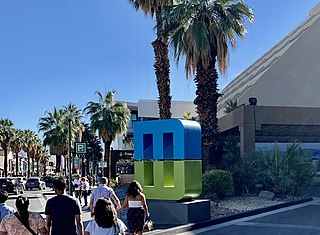
Richard Joseph Neutra was an Austrian-American architect. Living and building for the majority of his career in Southern California, he came to be considered a prominent and important modernist architect. His most notable works include the Kaufmann Desert House in Palm Springs, California.

Fallingwater is a house designed by the architect Frank Lloyd Wright in 1935 in the Laurel Highlands of southwest Pennsylvania, about 70 miles (110 km) southeast of Pittsburgh in the United States. It is built partly over a waterfall on Bear Run in the Mill Run section of Stewart Township, Fayette County, Pennsylvania. The house was designed to serve as a weekend retreat for Liliane and Edgar J. Kaufmann, the owner of Pittsburgh's Kaufmann's Department Store.

Albert Kahn was an American industrial architect. He was accredited the architect of Detroit and designed industrial plant complexes such as the Ford River Rouge automobile complex. He designed the construction of Detroit skyscrapers and office buildings as well as mansions in the city suburbs. He led an organization of hundreds of architect associates and in 1937, designed 19% of all architect-designed industrial factories in the United States. Under a unique contract in 1929, Kahn established a design and training office in Moscow, sending twenty-five staff there to train Soviet architects and engineers, and to design hundreds of industrial buildings under their first five-year plan. They trained more than 4,000 architects and engineers using Kahn's concepts. In 1943, the Franklin Institute posthumously awarded Kahn the Frank P. Brown Medal.
Albert Frey was a Swiss-born architect who established a style of modernist architecture centered on Palm Springs, California, United States, that came to be known as "desert modernism".
Villahermosa is a city in Mexico and the capital of Tabasco state.
Emerson Stewart Williams, FAIA was a prolific Palm Springs, California-based architect whose distinctive modernist buildings, in the Mid-century modern style, significantly shaped the Coachella Valley's architectural landscape and legacy.

Mid-century modern (MCM) is a design movement in interior, product, graphic design, architecture, and urban development that was popular in the United States and Europe from roughly 1945 to 1969, during the United States's post–World War II period. The term was used descriptively as early as the mid-1950s and was defined as a design movement by Cara Greenberg in her 1984 book Mid-Century Modern: Furniture of the 1950s. It is now recognized by scholars and museums worldwide as a significant design movement. The MCM design aesthetic is modern in style and construction, aligned with the Modernist movement of the period. It is typically characterized by clean, simple lines and honest use of materials, and it generally does not include decorative embellishments.

Edgar Jonas Kaufmann was an American businessman and philanthropist who owned and directed Kaufmann's Department Store, in Pittsburgh. He is also known for commissioning two modern architectural masterpieces, Fallingwater, designed by Frank Lloyd Wright and the Kaufmann Desert House in Palm Springs, designed by Richard Neutra.

Julius Shulman was an American architectural photographer best known for his photograph "Case Study House #22, Los Angeles, 1960. Pierre Koenig, Architect." The house is also known as the Stahl House. Shulman's photography spread the aesthetic of California's Mid-century modern architecture around the world. Through his many books, exhibits and personal appearances his work ushered in a new appreciation for the movement beginning in the 1990s.

The Kaufmann Desert House, or simply the Kaufmann House, is a house in Palm Springs, California, that was designed by architect Richard Neutra in 1946. It was commissioned by Edgar J. Kaufmann, Sr., a businessman who also commissioned Fallingwater by Frank Lloyd Wright.
Alan Hess is an American architect, author, lecturer and advocate for twentieth-century architectural preservation.

John Porter Clark (1905–1991) was an American architect. He worked with Albert Frey on several projects in Palm Springs, California, and was part of the Van Pelt and Lind firm. He has been referred to as a "mid-century modernist", and credited as one of the pioneers of "Desert Modernism", by using local rock, concrete blocks, metal and glass. His own house, the John Porter Clark House (1939) in Palm Springs, has been described as being in the international style and as one of the earliest examples of residential modern architecture in Southern California.
Juergen Nogai is a German architecture, art and documentary photographer.

Charles Prosper Wolff Schoemaker was a Dutch architect who designed several distinguished Art Deco buildings in Bandung, Indonesia, including the Villa Isola and Hotel Preanger. He has been described as "the Frank Lloyd Wright of Indonesia," and Wright had a considerable influence on Schoemaker's modernist designs. Although he was primarily known as an architect, he was also a painter and sculptor.
The Aluminaire House was designed as a case study by architects A. Lawrence Kocher and Albert Frey in April, 1931. The three-story house, made of donated materials and built in ten days, was the first all-metal house in the United States. It was shown in the Grand Central Palace exhibition hall on Lexington Avenue in New York City as part of the Architectural and Allied Arts Exhibition. In 1932 the house was exhibited again, this time at the Architectural League of New York show sponsored by the Museum of Modern Art (MOMA). The MOMA show was titled The International Style - Architecture Since 1922, which became the basis of a book by Philip Johnson and Henry Russell Hitchcock, The International Style, a manifesto for the International Style of architecture.

Andrew David Whalley is an architect registered in the United Kingdom and United States of America. His speciality is ecological design. In 2011, he was named Deputy Chairman of the international architecture firm Grimshaw Architects. He became chairman in 2019.

William Francis Cody was an influential desert modern architect working in Palm Springs during the peak of the Modern Architecture Movement. Like many of the architects during the mid-20th century, Cody designed almost anything Palm Springs allowed him to; houses, cluster housing, churches, offices, restaurants, schools, hotels, and club houses. His residential projects illustrated simplicity of form, natural light, and large windows displaying a smooth connection between interior and exterior. Cody maintained a diverse practice in the Coachella Valley of California. His work included designing country clubs, residences, hotels, a library, and church projects in Palm Springs, Indian Wells, Rancho Mirage, Palm Desert, and in southern California, Arizona, Mexico, and Cuba.
Barbara Bestor is an American architect based in Los Angeles, California. She is the principal of Bestor Architecture, founded in 1992. Examples of her work include the Beats Electronics Headquarters in Culver City, Blackbirds, small lot housing in Los Angeles, Intelligentsia Coffee & Tea in Los Angeles, the revitalization of Silvertop, originally designed by John Lautner and the Toro Canyon House in Santa Barbara. In 2017 she was elected to the AIA's College of Fellows.
The Palm Springs School of Architecture, often called Desert Modernism, is a regional style of post-war architecture that emerged in Palm Springs, California. Many of the architects who pioneered this style became world-renowned later in their own careers. Numerous buildings and homes by these architects remain in the Coachella Valley. Additionally, this style of architecture is showcased annually at the Modernism Week event in Palm Springs.

Modernism Week is a 501(c)(3) organization which provides public education programming fostering knowledge and appreciation of modern architecture, the mid-century modern architecture and design movement, the Palm Springs School of Architecture, as well as contemporary considerations surrounding historic preservation, cultural heritage, adaptive reuse, and sustainable architecture. Modernism Week provides annual scholarships to local students pursuing college educations in the fields of architecture and design and supports local and state organizations' efforts to preserve and promote the region's modern architecture. The organization is centered in the greater Palm Springs, California area in the Coachella Valley which is home to a significant collection of extant residential and commercial buildings designed in the mid-century modern vernacular.













